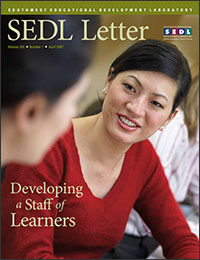Professional Development at the State Level: The Work of the Southeast Comprehensive Center and the Texas Comprehensive Center
When it comes to schools, there’s a clear hierarchy: students report to teachers, who report to principals. If you take it a step further, to the district level, principals report to superintendents. Many people forget that beyond that, there’s the state department of education. Just like teachers, principals, and superintendents need technical assistance and professional development, so do administrators at the state level. SEDL’s Southeast Comprehensive Center (SECC) and Texas Comprehensive Center (TXCC) help fill that need.
The SECC and the TXCC are two of the 16 regional comprehensive centers funded under the No Child Left Behind Act (NCLB). The centers were established to help states build their capacity to meet the needs of children served under NCLB. Specifically, the SECC and the TXCC work with state departments of education to identify and address each state’s particular issues and needs. Through tailored professional development, the SECC and the TXCC are able to better serve each state—and thereby each district, school, and student within that state.
Supporting the South: The Southeast Comprehensive Center
The SECC provides high-quality professional development and technical assistance to the states of Alabama, Georgia, Louisiana, Mississippi, and South Carolina. It works to build the capacities of states in its region to (1) implement the programs and goals of NCLB and (2) provide sustained support of high-needs districts and schools. To accomplish these goals, SECC staff met with key leaders within each state’s department of education to discuss how to best meet their needs. These discussions led to the creation of a Memorandum of Understanding for each state, which was used to develop a work plan for the SECC.
The work varies depending on the state, although similar patterns do emerge. In Alabama, the Alabama Department of Education requested that an SECC staff member serve on the Alabama Accountability Roundtable (ART). The ART’s mission is to provide a seamless system of technical assistance and support to schools in the areas of curriculum, instruction, fiscal responsibility, management, and leadership. The goal of this effort is to enable the schools and systems to achieve and maintain annual measurable objectives.
In September 2006, the ART conducted a needs-sensing survey of school improvement leaders, regional school improvement coaches, and peer mentors who serve on the State Support Team. Using the results of this survey, the SECC developed four professional development sessions: (1) “The Effect of Cultural Relevance on the High School Graduation Rate,” (2) “How to Establish and Implement an Effective Mentoring Program,” (3) “Writing Effective Goals, Strategies, and Benchmarks in Reading, Math, and Science,” and (4) “Addressing the High School Graduation and Drop-Out Rate.” Thus far, the SECC has presented each of these sessions at least twice, for a total of 21 days of professional development from October 2006 to March 2007. The professional development was conducted for School Support Team members who, in turn, replicate the training at schools and districts.
In Georgia, the SECC provides training-of-trainers professional development on evidence-based instructional strategies. Professional development on effective reading strategies and effective questioning skills was provided to the Heart of Georgia Regional Educational Service Agency at the request of the Georgia Department of Education.
In Louisiana, SECC staff met with Louisiana Department of Education (LDE) leadership staff in March 2006 to identify state needs. Since then, SECC staff have been busy conducting numerous professional development activities in targeted areas. One key area has been reading and literacy, which spans all divisions at the department. The activities have focused on (1) the K–12 literacy plan, (2) adolescent literacy “catch-up” programs, (3) the Dynamic Indicators of Basic Early Literacy Skills (DIBELS), (4) best practices in teaching reading and writing, and (5) state staff study groups in which reading reports are used to help inform the statewide reading research professional development plan for districts and schools.
These activities have helped move forward new ideas in the state. One SECC staff member, for example, served on a four-member expert review team to review numerous adolescent literacy “catchup” programs and provide the LDE with feedback on the strengths and weaknesses of each program. The SECC then guided the LDE to use the feedback to create a guide to assist districts in choosing a program that aligns with the district’s reading program, meets the specific reading needs of the district’s students, and accelerates the learning of at-risk students who read 2 or more years below grade level. Thus far 10 districts have received state funding to pilot one of two adolescent literacy “catch-up” programs, and several others are using local funds to implement one of the programs described as research-based in the state guide.
“The SECC has been instrumental in helping us identify research-based intervention programs to accelerate the learning of struggling adolescent readers,” says Donna Nola-Ganey, LDE assistant superintendent. “The catch-up programs are an important part of our overall effort to reduce the dropout rate and meet the needs of our most vulnerable high school students.”
In Mississippi, one focus of the SECC’s work has been on providing technical assistance in math and science. SECC staff helped the state revise its math and science curriculum frameworks. Mississippi Department of Education (MDE) staff requested SECC staff to review the curriculum frameworks for vertical and horizontal alignment, consistency in wording, and measurability and to align the standards with national standards. SECC staff also facilitated a 2-day meeting with members of the science curriculum frameworks revision committee to review the frameworks. The MDE is in the process of finalizing the revisions.
Additionally, two intensive professional development activities on NCLB were conducted for MDE staff members during January and February of 2007. The goal of these professional development activities was for participants to become familiar with the basic program requirements of Title I, Part A of NCLB. Each professional development activity was designed to help participants (1) identify and explain key concepts; (2) incorporate legislative requirements into their decision-making processes; and (3) locate key information in NCLB when necessary. The MDE has requested that this professional development activity be conducted again later this spring.
In February, SECC staff also facilitated a work session with the MDE Office of Leadership and Professional Development to revise the current professional development standards and professional development monitoring instrument. The state professional development model was also revised during this session. The MDE is in the process of compiling the revisions, and the SECC is holding a follow-up session to help.
Finally, in South Carolina, the state department of education asked the SECC to build its capacity to better evaluate the implementation of a new curriculum used in three corrective action districts. Under NCLB, states must identify for improvement any Title I school or district that does not meet the state’s definition of adequate yearly progress for 2 consecutive years. If the school or district does not meet AYP during the next school year, the school or district enters corrective action. The South Carolina Department of Education (SCDOE) identified three districts as qualifying for corrective action during the 2006–2007 school year. The state selected the option to implement a new curriculum in the districts. The SCDOE is working with the SECC and consultants to provide vital technical assistance in monitoring the effectiveness of the implementation of the new curriculum. The SECC has also helped the SCDOE in the delivery of professional development for instructional and leadership staff in the three districts.
Building the Base: The Texas Comprehensive Center
The purpose of the TXCC is to provide technical assistance and support to the Texas Education Agency (TEA) to ensure Texas has an education system with the capacity to eliminate achievement gaps and enable all students to achieve at high levels. Although the TXCC works with only one state—unlike the SECC’s five states—the large and diverse geographic region that is Texas provides its own set of challenges. The TXCC staff met with the TEA to identify these various challenges and ways to address them.
The TXCC has two basic goals: (1) to build the capacity of TEA and (2) to build the capacity of the state infrastructure to meet the intent and purposes of NCLB. To achieve the first goal, TXCC staff meet with TEA staff once a month to discuss emerging needs and appropriate methods of addressing them. Thus far, the TXCC has provided technical assistance on such topics as school improvement, restructuring, defining rigor in science courses, evaluating supplemental education services, and state plans for ensuring teacher quality. Connecting TEA staff to experts in these areas, such as those from the National Content Centers, and providing information about what other states are doing to implement NCLB are two forms of technical assistance that seem to be of particular value.
To achieve the second goal, TXCC staff provide professional development to the education service centers (ESCs) throughout the state. This training has focused on leadership development and instructional practice. TXCC staff have led sessions with ESC staff to help them learn how to build principals’ capacity for meeting with teachers as a faculty and in one-on-one coaching sessions where together they analyze data and use the results for improving student outcomes. TXCC staff also provide professional development for ESC staff who work directly with teachers. These sessions have focused on instructional strategies and support for English language learners in math and science in high school.
The TXCC provides ongoing support in its professional development activities. TXCC staff also try to tailor the sessions to the needs of the group. Haidee Williams, the TXCC’s state liaison, says TXCC staff ask for feedback from participants and plan accordingly.
"At the end of the second day of one training, we asked, 'What do you want to learn more about on days three and four?'” Williams says. “They gave us a list of 15 topics, and we said, ‘OK, out of these 15, what are your top three?’ Those were the topics for the next session.”
Williams points out that Texas has a good support system in place with TEA, the Title I Statewide School Support/Parental Involvement Initiative, the 20 ESCs, and the School Improvement Resource Center. She says the TXCC is working to build the capacity of all of the initiatives to work together more efficiently.
“Compared to many states, Texas has a fantastic infrastructure to support schools," she says. “We're looking to coordinate our work to support the implementation of NCLB that is infused within this system, rather than just running parallel to it.”
The Future Role of the Comprehensive Centers
In each state, the state liaison meets regularly to discuss and plan professional development activities for state staff based on current and future needs. This constant communication has helped both the states and the comprehensive centers meet their goals. In Texas, for example, five ESCs are partnering in Spring 2007 to redeliver the school improvement process from the TXCC’s summer forum, and other centers have done this on an individual basis.
“One indicator of the success of our professional development sessions comes from the fact that the Alabama State Department of Education is already asking us to provide more professional development next year,” says Lou Meadows, the SECC’s state liaison for Alabama. “I guess we could say repeat customers are a good indication that we are giving the clients what they need.”

In the photo above, President George W. Bush, and New Orleans mayor Ray Nagin, left, visit with Dr. Anthony “Tony” Recasner, principal of the Samuel J. Green Charter School, and third-grade students on March 1, 2007. President Bush visited the Gulf Coast region to see the recovery progress of communities devastated by Hurricane Katrina. Dr. Recasner served on the SEDL board from 1998–2004. White House photo by Eric Draper.
Next Article: New Parent Booklets Encourage Literacy Activities at Home

